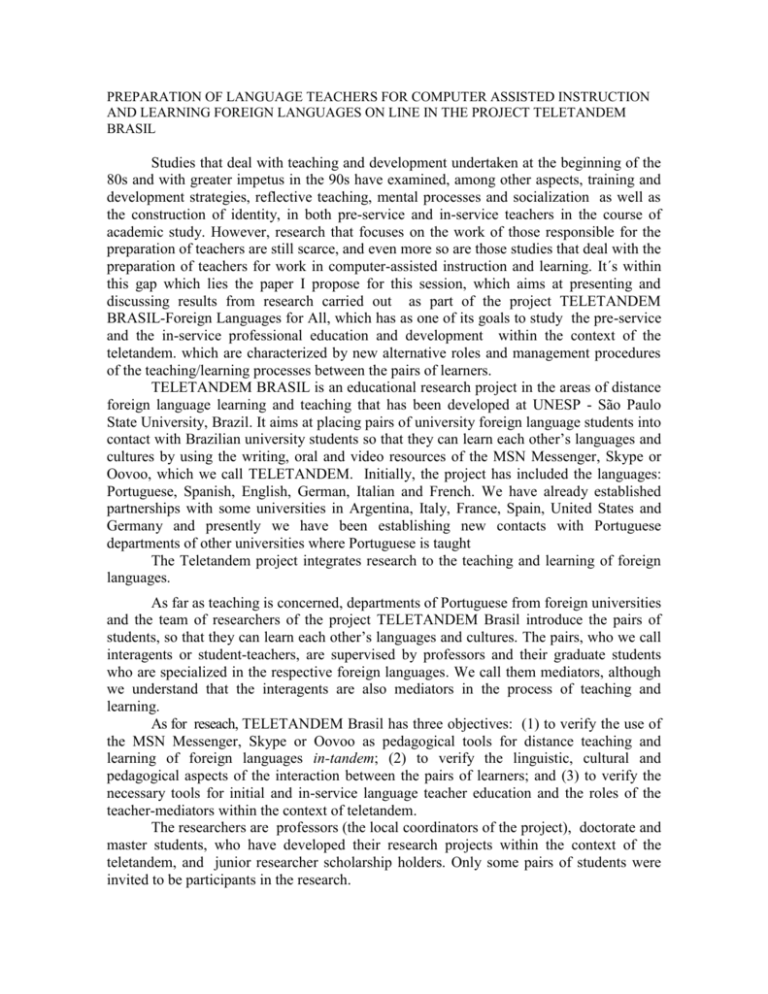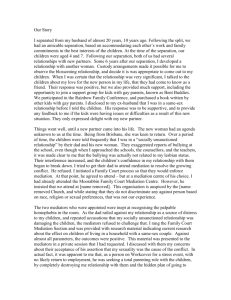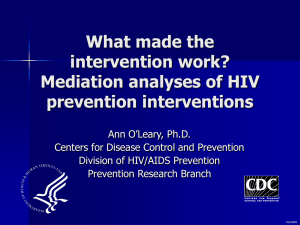Preparation of Language Teachers for Computer Assisted
advertisement

PREPARATION OF LANGUAGE TEACHERS FOR COMPUTER ASSISTED INSTRUCTION AND LEARNING FOREIGN LANGUAGES ON LINE IN THE PROJECT TELETANDEM BRASIL Studies that deal with teaching and development undertaken at the beginning of the 80s and with greater impetus in the 90s have examined, among other aspects, training and development strategies, reflective teaching, mental processes and socialization as well as the construction of identity, in both pre-service and in-service teachers in the course of academic study. However, research that focuses on the work of those responsible for the preparation of teachers are still scarce, and even more so are those studies that deal with the preparation of teachers for work in computer-assisted instruction and learning. It´s within this gap which lies the paper I propose for this session, which aims at presenting and discussing results from research carried out as part of the project TELETANDEM BRASIL-Foreign Languages for All, which has as one of its goals to study the pre-service and the in-service professional education and development within the context of the teletandem. which are characterized by new alternative roles and management procedures of the teaching/learning processes between the pairs of learners. TELETANDEM BRASIL is an educational research project in the areas of distance foreign language learning and teaching that has been developed at UNESP - São Paulo State University, Brazil. It aims at placing pairs of university foreign language students into contact with Brazilian university students so that they can learn each other’s languages and cultures by using the writing, oral and video resources of the MSN Messenger, Skype or Oovoo, which we call TELETANDEM. Initially, the project has included the languages: Portuguese, Spanish, English, German, Italian and French. We have already established partnerships with some universities in Argentina, Italy, France, Spain, United States and Germany and presently we have been establishing new contacts with Portuguese departments of other universities where Portuguese is taught The Teletandem project integrates research to the teaching and learning of foreign languages. As far as teaching is concerned, departments of Portuguese from foreign universities and the team of researchers of the project TELETANDEM Brasil introduce the pairs of students, so that they can learn each other’s languages and cultures. The pairs, who we call interagents or student-teachers, are supervised by professors and their graduate students who are specialized in the respective foreign languages. We call them mediators, although we understand that the interagents are also mediators in the process of teaching and learning. As for reseach, TELETANDEM Brasil has three objectives: (1) to verify the use of the MSN Messenger, Skype or Oovoo as pedagogical tools for distance teaching and learning of foreign languages in-tandem; (2) to verify the linguistic, cultural and pedagogical aspects of the interaction between the pairs of learners; and (3) to verify the necessary tools for initial and in-service language teacher education and the roles of the teacher-mediators within the context of teletandem. The researchers are professors (the local coordinators of the project), doctorate and master students, who have developed their research projects within the context of the teletandem, and junior researcher scholarship holders. Only some pairs of students were invited to be participants in the research. My personal research project, of which results will be the focus of this presentation, fits the third research question and focuses on two main goals: 1- How initial teacher education is carried out in the teletandem and which are the necessary tools for this kind of teacher education; 2- How mediation occurs and which are the necessary tools for the teacher mediators. It´s conceptual framework includes Teacher Education Studies (Zeichner and Liston, 1996;Woods, 1996; Almeida Filho, 1999; Gebhard and Oprandy, 1999; Johnson, 1999; Trappes-Lomax and McGrath, 1999; Richards and Renandya, 2002; Gimenez, 2002; 2003; Kumaravadivelu, 2003; Celani, 2003; Zeichner, 2003; Telles, 2004; Vieira-Abrahão, 2004; Richards and Farrell, 2005; Benson and Nunan, 2005;and others); Studies about Beliefs and Cognition (Gimenez, 1994; Johnson, 1999; Barcelos, 2000; 2001;2003; 2004; Borg, 1998;2003;2006; Kalaja and Barcelos, 2003; Lima, 2005; Silva, 2005; Barcelos and Vieira-Abrahão, 2006;among others) and Studies about Technology in Language Learning and Teaching, in special about Tandem (Warschauer and Healey, 1998; Schwienhhorst, 1998a; 1998 b; Appel and Mullen, 2000; 2002; Warschauer, 2000, 2004, Oliveira e Paiva, 2001, 2003; Brammerts, 2003; Brammerts and Calvert, 2003; Kern,Ware and Warschauer, 2004; Arnold and Ducate, 2006, among others). According to the methodological framework of the Teletandem project, qualitative approaches to research (Erickson, 1986; Bogdan & Bicklen, 1998 and Silverman, 2000) have been adopted.. Data has been collected by video-taping teletandem sessions, diaries written by the participants and teacher-mediators, interviews, questionnaires and autobiographies. The participants are pre-service teachers from the “Letter”undergraduate course. This choice is due to the fact that their involvement in the project gives them the opportunity of developing their linguistic and cultural competence in the foreign language in which they are majoring, besides putting them into teaching practice on line, preparing them for their future professional performance with technological resources. Each student-teacher involved with the Teletandem practice has a mediator, who acts as a teacher educator. The mediators are master and PhD students who have developed their research work inside the project. They are supported by their respective supervisors. We understand that while involved in the mediation work, which is also developed on line, our PhD and Master students have been prepared for acting as teacher educators, function that most of our students play when they start working in the undergraduate level. Before starting the interactions we developed a preparation work with the studentteachers and the mediators. Besides discussing texts related to technology and language teaching, teletandem and some norms related to the functioning of the teletandem sessions, which are suggested by the project, and different ways of data collection, we discussed a variety of texts on Teaching Portuguese as a foreign language, Culture, Fluency and Accuracy; Communicative Competence; Affection and teaching and learning and error correction and treatment, among others. Separately with the mediators, we discussed texts on teacher initial education, focusing especially on ways of approaching the pre-service teacher in order to help him/her in the teaching practice; ways of enhancing his/her reflective capability etc. After many readings and discussions we wrote collaboratively orientations for teacher mediation which will be shown during my presentation. So far, results have shown that: 1- Mediations are seen positively by the studentteachers. They feel safe to have someone to talk to and discuss their doubts and difficulties; 2-The atmosphere created by the mediator and interagents is relaxed, friendly and of collaboration; 3- Mediators regularly use non-directive and alternative strategies of mediation during the first mediations; 4-After some time of practice and mediation, when they feel the student-teachers are more secure of their work, exploratory and collaborative strategies are also used; 5-Mediators prepare their mediation sessions based on the studentteacher’s interaction and his/her interaction diary. They analyze the student-teacher’s practice, select points for discussion and in some cases suggest theoretical readings; 6Student-teachers have the chance of experiencing their profession for the first time with the support of a mediator, who is following his work and is ready to help him in his wants and difficulties;7-Theory introduced by the mediator according to the interagent’s pedagogical necessities is meaningful to them; 8-Student-teachers had difficulty teaching Portuguese to foreigners.9-The Teletandem principles are put into practice along the process;10-Teacher mediation promotes the master and doctorate students’ reflections and development. These results and some others will be discussed in the presentation of this paper with the support of the triangulated data and the theoretical foundation. RELEVANT REFERENCES: BAILEY, K. M. The use of diary studies in teacher education programs in: RICHARDS, . J. C.; NUNAN, D. (eds.) Second Language Teacher Education. New York: Cambridge: CUP, p. 215-226. BRAMMERTS, H. Autonomous Language Teaching in tandem. In: Lewis T. & Walker, L. (eds).Autonomous Language Learning In-Tandem. Sheffield, UK: Academic Electronic Publications, 2003. p. 44427-36. DAWSON, K. M. et. al. Results of a telecolaborative activity involving geographically disparate preservice teachers. 2006. Documento on-line http://teleduc.assis.unesp.br/cursos/diretorio/leituras_18_7 DELLILE, K.H. & CHICHORRO FERREIRA, A. (eds.) Aprendizagem autónoma de línguas en Tandem (Textos pedagogicos e didácticos. 12). Lisboa: Colibri, Facultade de Letras da Universidade de Coimbra, 2002. ERICKSON, F. Qualitative methods in research on teaching. In: Wittrock, M.C. (ed.). Handbook of research on teaching. (3.ed.) 1986. FREEMAN, D.; RICHARDS, J. C. (Orgs.) Teacher Learning in Second Language Teaching. Cambridge: Cambridge University Press, 1996. JOHNSON, K. E. Understanding Language Teaching: reasoning in action. Heinle & Heinle, 1999. KUMARAVADIVELU, B. Understanding Postmethod. In: Beyond Methods: Macrostrategies for Language Teaching. Yale University Press, 2003. NÓVOA, A.(org.). Formação de professores e profissão docente. Os professores e a sua formação. Lisboa: Publicações Dom Quixote, 1999, p.15-33. RICHARDS, K. Theory in Practice: Design and Argument in Day-to-Day Teaching. In: TRAPPES-LOMAX; MEGRATH, I. Theory in language Teacher Education. Longamar, 1999. ___..; LOCKHART, C. Reflective teaching in second language classrooms. Cambridge: Cambridge University Press, 1995. ___; FARRELL, T.C. Professional Development for Language Teachers: strategies for teacher learning. Cambridge: Cambridge University Press, 2005. SCHON, D. (1983) the Reflective Practitioner. New York: Basic books,1983 ___. Educando o profissional reflexivo: um novo design para o ensino e a aprendizagem. Porto Alegre: Artes Médicas Sul, 1998. SILVERMAN, D. Doing qualitative research: a practical handbook. Londres: Sage, 2000.









